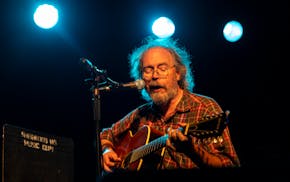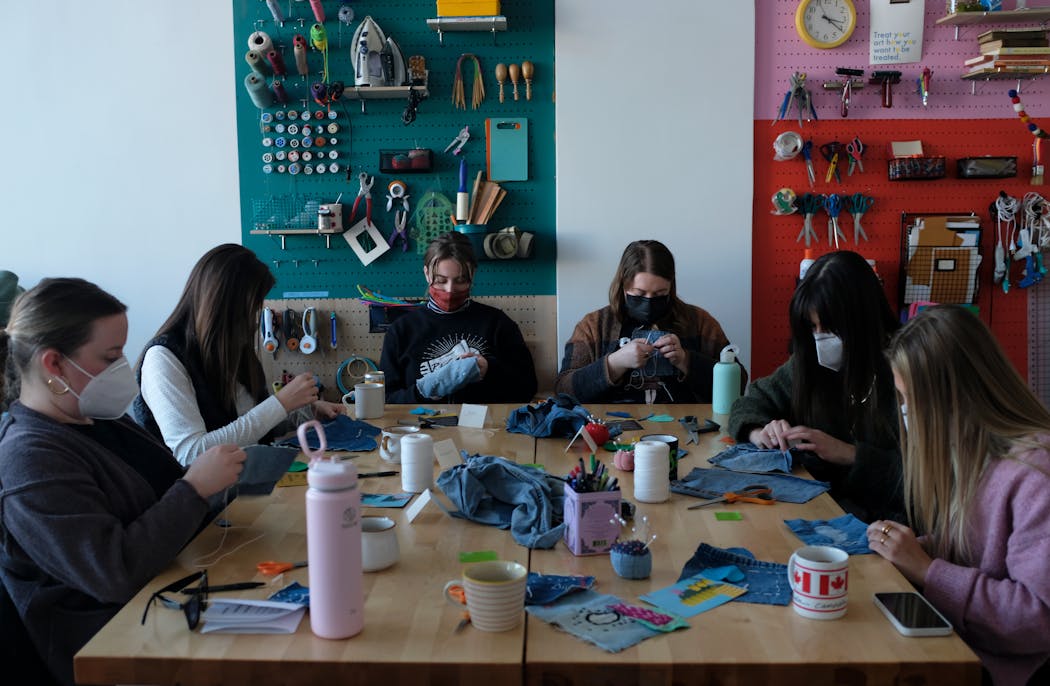About a dozen people sat around a big table in a bright, cheery room on a recent evening, playing with art.
Some painted. Some made collages out of photos from magazines or prints. One person sculpted a life-size hand from masking tape and other materials.
"I recently broke my pinky finger," the hand sculptor said, when attendees were offered a chance to share and explain their work. With the finger finally healed, the hand sculpture was "an expression of the freedom that your body gives you," she said.
"I'm also really chuffed that I made a hand," she added, drawing laughter around the table.
That pretty much summarizes the objectives of Open Studio, a regular free event offered by Curiosity Studio in Minneapolis. It provides community art therapy, a loosely defined experience that operates outside the formal structures of both art education and clinical psychotherapy.
"If there's one thing you should know about Curiosity Studio it's that we're excited for you to do what feels good," Lauren Callis, a trained art therapist and executive director of the studio, told the attendees.
The class began with a five-minute YouTube video in which Minneapolis artist and community organizer Ricardo Levins Morales talks about colonialism, diaspora, ancestors and descendants. Participants were lightly encouraged, though not required, to let Morales' messages inspire their evening's artwork.
After that, everyone was invited to help themselves to the studio's art supplies — paints, brushes, markers, thread, scissors, magazines and other pictures for collages — and create whatever they felt like creating.
Curiosity Studio's version of community art therapy features a laid-back approach to both art and therapy. The goal of the art isn't creating an enduring masterpiece or even necessarily honing artistic skills. And the goal of the therapy isn't treating clinical conditions or serious mental health problems, Callis said in an interview.
It's a research-based model whose objectives are open-ended, she said.
"I think that our society is really, really, really addicted to what the outcome is," Callis said. "We want to have something to hold in our hands and say, 'This is it, I've figured it out.' And that's just not the way the world works."
Instead, the class provides "a space where you can intentionally make art as a way to get to know yourself and others." Participants can explore their own creativity in an environment almost free of rules or structure. They can interact with other people, many of whom they might not have previously met, although again there's no conversational requirement.
"We're trying not to be too prescriptive about it," Callis said. "We want people to find their own path."
The results can be as simple as coming out of a session thinking, "OK, cool, I learned I can make a collage and that can be a way to pass two hours of time that's not sitting and scrolling on my phone or going out to a bar."
Shared space
In that sense, Callis said, community art therapy can help fill a role once more commonly held by civic groups and houses of worship, organizations whose membership has been declining for decades. In his 2000 book "Bowling Alone: The Collapse and Revival of American Community," author and political scientist Robert D. Putnam explores the societal and individual damage resulting from the disappearance of community organizations and their accompanying social connections.
This week, U.S. Surgeon General Dr. Vivek Murthy issued a report about the "epidemic of loneliness and social isolation" affecting the country, warning that loneliness poses a health threat as serious as smoking and laying out a framework for a "National Strategy to Advance Social Connection."
"A lot of people really value that shared space," Callis said. "There are new things you can learn about yourself from being in a group of people where the expectation isn't that you exit as friends."
In the recent session, participants mostly talked quietly with people sitting near them. But sometimes the classes involve group-wide discussions, Callis said.
There are also Open Studios sessions specifically for people of color or members of the LGBTQ+ community. Other affinity groups, such as caregivers or people grieving, are being considered.
Curiosity Studio also offers paid classes, including some that teach practical skills such as mending and woodwork. There are workshops and team-building sessions for community groups and businesses. A program called Curiosity 101 is art therapy similar to that of Open Studio but with a more structured approach involving ice-breaking activities and simple art materials.
The goals are as simple as "How can we leave our emotional space better than we found it?" Callis said. "How it works is however it's going to work for somebody,"

Critics' picks: The 11 best things to hear, do and see in the Twin Cities this week

Critics' picks: The 9 best things to do and see in the Twin Cities this week

The 5 best things our food writers ate this week

The 5 best things our food writers ate this week



